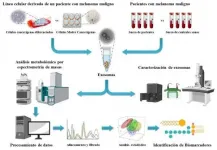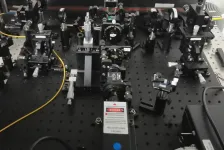(Press-News.org) WASHINGTON -- Researchers have developed a new microscopy technique that can acquire 3D super-resolution images of subcellular structures from about 100 microns deep inside biological tissue, including the brain. By giving scientists a deeper view into the brain, the method could help reveal subtle changes that occur in neurons over time, during learning, or as result of disease.
The new approach is an extension of stimulated emission depletion (STED) microscopy, a breakthrough technique that achieves nanoscale resolution by overcoming the traditional diffraction limit of optical microscopes. Stefan Hell won the 2014 Nobel Prize in Chemistry for developing this super-resolution imaging technique.
In Optica, The Optical Society's (OSA) journal for high impact research, the researchers describe how they used their new STED microscope to image, in super-resolution, the 3D structure of dendritic spines deep inside the brain of a living mouse. Dendric spines are tiny protrusions on the dendritic branches of neurons, which receive synaptic inputs from neighboring neurons. They play a crucial role in neuronal activity.
"Our microscope is the first instrument in the world to achieve 3D STED super-resolution deep inside a living animal," said leader of the research team Joerg Bewersdorf from Yale School of Medicine. "Such advances in deep-tissue imaging technology will allow researchers to directly visualize subcellular structures and dynamics in their native tissue environment," said Bewersdorf. "The ability to study cellular behavior in this way is critical to gaining a comprehensive understanding of biological phenomena for biomedical research as well as for pharmaceutical development."
Going deeper
Conventional STED microscopy is most often used to image cultured cell specimens. Using the technique to image thick tissue or living animals is a lot more challenging, especially when the super-resolution benefits of STED are extended to the third dimension for 3D-STED. This limitation occurs because thick and optically dense tissue prevents light from penetrating deeply and from focusing properly, thus impairing the super-resolution capabilities of the STED microscope.
To overcome this challenge, the researchers combined STED microscopy with two-photon excitation (2PE) and adaptive optics. "2PE enables imaging deeper in tissue by using near-infrared wavelengths rather than visible light," said Mary Grace M. Velasco, first author of the paper. "Infrared light is less susceptible to scattering and, therefore, is better able to penetrate deep into the tissue."
The researchers also added adaptive optics to their system. "The use of adaptive optics corrects distortions to the shape of light, i.e., the optical aberrations, that arise when imaging in and through tissue," said Velasco. "During imaging, the adaptive element modifies the light wavefront in the exact opposite way that the tissue in the specimen does. The aberrations from the adaptive element, therefore, cancel out the aberrations from the tissue, creating ideal imaging conditions that allow the STED super-resolution capabilities to be recovered in all three dimensions."
Seeing changes in the brain
The researchers tested their 3D-2PE-STED technique by first imaging well-characterized structures in cultured cells on a cover slip. Compared to using 2PE alone, 3D-2PE-STED resolved volumes more than 10 times smaller. They also showed that their microscope could resolve the distribution of DNA in the nucleus of mouse skin cells much better than a conventional two-photon microscope.
After these tests, the researchers used their 3D-2PE-STED microscope to image the brain of a living mouse. They zoomed-in on part of a dendrite and resolved the 3D structure of individual spines. They then imaged the same area two days later and showed that the spine structure had indeed changed during this time. The researchers did not observe any changes in the structure of the neurons in their images or in the mice's behavior that would indicate damage from the imaging. However, they do plan to study this further.
"Dendritic spines are so small that without super-resolution it is difficult to visualize their exact 3D shape, let alone any changes to this shape over time," said Velasco. "3D-2PE-STED now provides the means to observe these changes and to do so not only in the superficial layers of the brain, but also deeper inside, where more of the interesting connections happen."
INFORMATION:
Paper: M. G. M. Velasco, M. Zhang, J. Antonello, P. Yuan, E. S. Allgeyer, D. May, O. M'Saad, P. Kidd, A. E. S. Barentine, V. Greco, J. Grutzendler, M. J. Booth, J. Bewersdorf, "3D super-resolution deep-tissue imaging in living mice," Optica 8(4), 442-450 (2021).
DOI: https://doi.org/10.1364/OPTICA.416841.
About Optica
Optica is an open-access, journal dedicated to the rapid dissemination of high-impact peer-reviewed research across the entire spectrum of optics and photonics. Published monthly by The Optical Society (OSA), Optica provides a forum for pioneering research to be swiftly accessed by the international community, whether that research is theoretical or experimental, fundamental or applied. Optica maintains a distinguished editorial board of more than 60 associate editors from around the world and is overseen by Editor-in-Chief Prem Kumar, Northwestern University, USA. For more information, visit Optica.
About The Optical Society
Founded in 1916, The Optical Society (OSA) is the leading professional organization for scientists, engineers, students and business leaders who fuel discoveries, shape real-life applications and accelerate achievements in the science of light. Through world-renowned publications, meetings and membership initiatives, OSA provides quality research, inspired interactions and dedicated resources for its extensive global network of optics and photonics experts. For more information, visit osa.org.
Media Contacts:
Aaron Cohen
(301) 633-6773
aaroncohenpr@gmail.com
mediarelations@osa.org
Serotonin, or 5-hydroxytryptamine (5-HT), is a kind of neurotransmitter. 5-HT can regulate multifaceted physiological functions such as mood, cognition, learning, memory, and emotions through 5-HT receptors. 5-HT receptors are a type of G protein-coupled receptor and can be divided into 12 subtypes in humans. As drug targets, they play a vital role in the treatment of schizophrenia, depression, and migraine.
However, the structural and functional mechanisms of 5-HT receptors have been largely unknown.
In a study published in Nature on March 24, Prof. H. Eric XU and Prof. JIANG Yi from the Shanghai Institute of Materia Medica (SIMM) of the Chinese Academy of ...
Their study has shown that these malignant melanoma vesicles produced by CSCs have a different molecular composition from that of differentiated tumour cells. These molecules were also found to be detectable in exosomes present in the blood, and they presented differences in patients with malignant melanoma compared to healthy individuals. This makes them potentially suitable as biomarkers for the diagnosis and prognosis of this disease.
The results have been published in the prestigious scientific journal Molecular Oncology.
Malignant melanoma is one of the most aggressive types of skin cancer and its prevalence has been increasing worldwide in recent years. Among the factors that contribute to the life-threatening nature and ...
Dr. Rosario González-Férez, a researcher at the Department of Atomic, Molecular and Nuclear Physics and the "Carlos I" Institute of Theoretical and Computational Physics of the University of Granada, has published the article "Ultralong-Range Rydberg Bi-molecules" in the prestigious scientific journal Physical Review Letters. The results of the study show a new type of bi-molecule formed from two nitric oxide (NO) molecules, both in their ground state and in the Rydberg electronic state.
The work was made possible thanks to the scientific collaboration between the researcher and the Institute for Theoretical Atomic, Molecular ...
The novel label-free assay uses unconventional L and inverse-L shaped pillars of deterministic lateral displacement (DLD) microfluidic technology to quantify and profile immune states of white blood cells (WBCs) by assessing biophysical properties of size, deformation, distribution, and cell count
The assay requires only 20 microlitres (μl) of unprocessed blood and takes just 15 minutes - much faster than existing methods which require up to 15 millilitres (ml) of blood and take at least a few hours to produce results
This new technology measures and profiles the often volatile host immune response, resulting in a more accurate assessment of patient pathophysiology
Current methods for early diagnosis of infection focus on ...
For almost a century, physicists have been intrigued by the fundamental question: why are complex numbers so important in quantum mechanics, that is, numbers containing a component with the imaginary number i? Usually, it was assumed that they are only a mathematical trick to facilitate the description of phenomena, and only results expressed in real numbers have a physical meaning. However, a Polish-Chinese-Canadian team of researchers has proved that the imaginary part of quantum mechanics can be observed in action in the real world.
We need to significantly reconstruct our naive ...
Researchers at Lund University in Sweden have investigated how the X and Y chromosomes evolve and adapt to each other within a population. The results show that breaking up coevolved sets of sex chromosomes could lead to lower survival rates among the offspring - something that could be of importance in species conservation, for example. The study is published in the journal PNAS.
The results provide new clues on how species are formed, and suggest it could be harmful to bring together individuals from different populations that have been separated for a long time. The reason is that the offspring have lower survival rates.
"This is something worth keeping in mind in conservation biology, where you want to see a population ...
By clearing forests, burning grasslands, plowing fields and harvesting crops, humans apply strong selective pressures on the plants that survive on the landscapes we use. Plants that evolved traits for long-distance seed-dispersal, including rapid annual growth, a lack of toxins and large seed generations, were more likely to survive on these dynamic anthropogenic landscapes. In the current article, researchers argue that these traits may have evolved as adaptations for megafaunal mutualisms, later allowing those plants to prosper among increasingly sedentary human populations.
The new study hypothesizes that the presence of specific anthropophilic traits explains why a select few plant families came to dominate the crop and weed ...
The claim that old-growth forests play a significant role in climate mitigation, based upon the argument that even the oldest forests keep sucking CO2 out of the atmosphere, is being refuted by researchers at the University of Copenhagen. The researchers document that this argument is based upon incorrectly analysed data and that the climate mitigation effect of old and unmanaged forests has been greatly overestimated. Nevertheless, they reassert the importance of old-growth forest for biodiversity.
Old and unmanaged forest has become the subject of much debate in ...
One big challenge for the production of synthetic cells is that they must be able to divide to have offspring. In the journal Angewandte Chemie, a team from Heidelberg has now introduced a reproducible division mechanism for synthetic vesicles. It is based on osmosis and can be controlled by an enzymatic reaction or light.
Organisms cannot simply emerge from inanimate material ("abiogenesis"), cells always come from pre-existing cells. The prospect of synthetic cells newly built from the ground up is shifting this paradigm. However, one obstacle on this path is the question of controlled division--a requirement for having "progeny".
A team from the Max Planck Institute for Medical Research in Heidelberg, Heidelberg ...
The team of researchers at Kaunas University of Technology (KTU), Lithuania applied artificial intelligence (AI) methods to evaluate data of human embryo development. The AI-based system photographs the embryos every five minutes, processes the data of their development and notifies any anomalies observed. This increases the likelihood of choosing the most viable and healthy early-stage embryo for IVF procedures. The innovation was developed in collaboration with Esco Medical Technologies, a manufacturer of medical equipment.
Almost one in six couples face infertility; about 48.5 million couples, 186 million individuals worldwide are inflicted. Europe has one of the lowest birth rates in the world, with an average of just 1.55 children per woman.
The most effective form of ...





